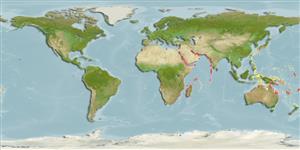Actinopterygii (ray-finned fishes) >
Perciformes (Perch-likes) >
Callionymidae (Dragonets)
Etymology: Callionymus: Greek, kallion, comparative of kallos = beautiful + Greek, onyma = name; with a better name . More on author: Regan.
Environment / Climate / Range
Ecology
Marine; demersal; depth range 1 - 20 m (Ref. 4405). Tropical, preferred ?
Western Indian Ocean: southern Red Sea to the Cape of Good Hope, the Persian Gulf, and southwestern India (Ref. 9608, 4405).
Size / Weight / Age
Maturity: Lm ? range ? - ? cm
Max length : 13.0 cm TL male/unsexed; (Ref. 30573); common length : 10.0 cm TL male/unsexed; (Ref. 9608)
Dorsal
spines
(total): 4;
Dorsal
soft rays
(total): 9;
Anal
spines: 0;
Anal
soft rays: 8. Color varies from yellow to dark brown; 1st dorsal fin of males light grey with dark lines, 1st and 4th spines longest; 1st dorsal fin of females black, 1st spine longest, 4th spine shortest (Ref. 4405).
Inhabits shallow sandy bottoms (Ref. 5213). Feeds on benthic crustaceans, worms and snails (Ref. 9608).
Life cycle and mating behavior
Maturity | Reproduction | Spawning | Eggs | Fecundity | Larvae
Fricke, R., 1986. Callionymidae. p. 770-774. In M.M. Smith and P.C. Heemstra (eds.) Smiths' sea fishes. Springer-Verlag, Berlin. (Ref. 4405)
IUCN Red List Status (Ref. 115185)
CITES (Ref. 94142)
Not Evaluated
Threat to humans
Harmless
Human uses
Fisheries: minor commercial
More information
Common namesSynonymsMetabolismPredatorsEcotoxicologyReproductionMaturitySpawningFecundityEggsEgg development
ReferencesAquacultureAquaculture profileStrainsGeneticsAllele frequenciesHeritabilityDiseasesProcessingMass conversion
Tools
Special reports
Download XML
Internet sources
